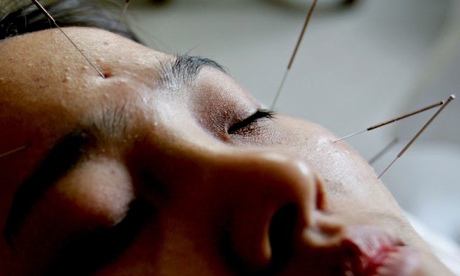
Arvind Singh came to Barefoot Acupuncturists in Mumbai’s Vijay Nagar slum to find relief from debilitating low-back pain. His chronic suffering forced him to leave his job as a security guard, eliminating the family’s sole income. “We went for x-rays, CT scans and blood tests, but no one could give us a diagnosis,” says his wife, Anita. Doctors prescribed painkillers and suggested surgery – both costly options. Eventually, the Singhs turned to acupuncture, where, after 15 treatments at 20 rupees a sitting, Singh felt “completely fine”.
Founded by Belgian Walter Fischer in 2008, Barefoot Acupuncturists now has four clinics – two in Mumbai’s slums and two in rural Tamil Nadu – to bring holistic care to low-income communities. Around the world, traditional medical systems, such as acupuncture and ayurveda are increasingly being recognised as affordable, low-tech interventions for under-served areas. In India, 65% of the rural population uses ayurveda and medicinal plants as a first step for healthcare. In Africa, traditional medicine serves 80% of healthcare needs. In China, the figure is about 40%.
“For many millions of people, often living in rural areas of developing countries, herbal medicines, traditional treatments and traditional practitioners are the main – sometimes the only – source of healthcare,” the World Health Organisation’s director general, Margaret Chan, said in 2008. “This is care that is close to homes, accessible and affordable.”
The WHO recently launched the traditional medicine strategy 2014-2023 to mainstream traditional medicine alongside allopathic (modern, western) care, with an emphasis on improving safety and expanding access. The report aims to set up traditional medicine for contemporary health needs, diseases and standards.
Traditional medicine in its many forms has proven to be an effective treatment for non-communicable diseases (NCDs) – one of the biggest health burdens for developing countries. NCDs, such as heart disease, stroke, cancer and chronic lung disease, kill more than 36 million people each year and 80% of the deaths occur in low- and middle-income countries.
Founder of AyurVaid chain of ayurvedic hospitals Rajiv Vasudevan says today’s “quick fix” society turns too quickly to pills and elective surgery but traditional medicine treats the root-cause. He says that allopathic medicine provides symptomatic treatment that, for example, returns blood pressure back to normal, but ignores the underlying conditions – a person’s constitution, the surrounding environment, diet – that cause the illness in the first place.
“In general, ayurveda can play an effective complementary role to allopathy’s emergency medical care system,” says Vasudevan, who believes the lowest economic strata can benefit the most from these choices in treatment. “Ayurveda offers an alternative option to elective surgery, which has multiple implications, including loss of livelihood, expense and irreversibility.” Ayurveda’s focus on long-term wellbeing is particularly important for vulnerable communities who rely on healthy bodies for a steady income.
Recognising the benefits of traditional medicine, the Indian government has included it in national schemes. The ayurveda, yoga and naturopathy, unani, siddha and homeopathy (Ayush) department in the ministry of health and family welfare focuses on upgrading education standards, quality control and expanding availability and awareness of these traditional systems. Ayush institutions across the country have approximately 62,000 hospital beds and more than 785,000 health workers.
Further, the government has included ayuveda in its insurance scheme, Rashtra Swastya Bima Yojana (RSBY). The decision came last August after petitioning from around the country, including by the Ayush regional coordinator in Uttar Pradash, Anand Chaudhary. He argued that “escalating cost of allopathic drugs is still a challenge to provide quality patient care with minimal resources. Ayurveda may help a great deal in this regard and ensure cost effective treatment to all.” In another move in line with WHO goals, the Indian government announced it would enlist a drug controller for traditional medicine.
Disproving sceptics through improved regulation and quality assurance is an important task for the new drug controller. Several scientific studies have found toxic substances in traditional medicine, including one that found ayurvedic medicines could cause lead poisoning.
“Traditional medicine is a very wide term and it incorporates many harmful as well as good practices,” says Armida Fernandez, founder of the NGO Society for Nutrition, Education and Health Action. While the organisation uses allopathic medicine to treat babies with pneumonia or tuberculosis, Sneha supports proven traditional practices, such as giving the mother nutritious sweets post-delivery to improve lactation.
Traditional medicine can’t be assumed to all be harmful, ineffective or beneficial, but the WHO’s new strategy will help to validate effective practices on an international level, encouraging countries to look more closely at expanding this medical option.
“Chronic disease and poverty operate in a vicious cycle,” says Vasudevan. “They feed off each other.” In this sense, providing quality medical care is more than a basic right; the physical wellbeing of low-income communities, particularly in the developing world, is one of the most fundamental tools in fighting poverty. As development advocates search for new technologies and innovations to pressing issues, ancient wisdom continues to prove its relevance in the 21st century – and if the WHO’s new strategy is influential – will only become more important.
Read more stories like this:
• Cancer: Kenya’s preventable killer
• 13 ways to tackle inequality in India
• India is polio-free: what can Pakistan, Afghanistan and Nigeria learn?
• Advertisement feature: New tools help strengthen local advocacy skills
Join our community of development professionals and humanitarians. Follow @GuardianGDP on Twitter.

